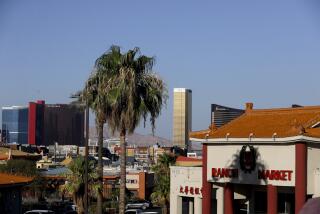Las Vegas’ Glitter Hides Seething Racial Tensions : Unrest: Violence, which erupted after the King verdicts, is continuing. A decline in tourism is feared.
- Share via
LAS VEGAS — Behind the flowing money and shimmering neon, promoters of this city’s fantasyland image are concerned that televised scenes of looters and police rolling into the ghetto in armored cars will scare off free-spending tourists.
In particular, they worry about regulars like Gene Real, who nursed a beer over a video poker game at the Mirage resort and spoke about his trips to Las Vegas--once a year for the last four decades.
“This is Mickey Mouse land--the bad things are far away,” said Real, a retired phone company manager from Northridge who came despite the reports of ongoing urban turmoil here. “As long as there aren’t riots on the Strip, you can still escape here.”
But with the mood still tense just a few miles away, local critics have warned gaming moguls that they need to worry less about image and more about the deteriorating, long-ignored west Las Vegas ghetto where violent looting and arson erupted after the verdicts in the Rodney G. King beating case in Los Angeles.
The growth boom that spurred the opening of hotels like the Mirage and made Las Vegas one of the nation’s fastest-growing big cities has bypassed the westside, a neighborhood of 20,000 across the railroad tracks from downtown’s Glitter Gulch and a few miles from the Strip hotel-casinos.
There is no tourist casino on the westside. Nor is there a bank, fast-food restaurant, pizza parlor or supermarket. There isn’t even bus service. Instead, there is mostly anger--directed at the roughhouse reputation of the Las Vegas police and at the Strip hotels, which employ relatively few blacks.
“Desperation has set in,” said Prof. Roosevelt Fitzgerald, chairman of the ethnic studies department at University of Nevada Las Vegas.
The arson and looting here after the April 29 verdicts never approached the widespread violence in Los Angeles. Small mobs took to westside streets and burned some businesses, doing about $6 million in damage. One person was killed, a teen-ager whose body was found in the rubble of a burned-out business.
Nevada National Guard troops were mobilized but never deployed on the streets. However, police patrolled in armored personnel carriers and blocked streets to keep black marchers from reaching the downtown casino area. Police have arrested 65 people in the unrest.
Scattered violence has continued in the weeks since the King verdicts. Shots have been fired at police and firefighters, a white motorist was pulled from his car in west Las Vegas. On the Memorial Day weekend, police in armored personnel carriers were fired on as they broke up a gathering of about 150 people at a park in the separate city of North Las Vegas.
In an effort to cool tensions, black leaders have quietly organized meetings between police and gang leaders in the back room of a bar owned by Las Vegas City Councilman Frank Hawkins. Hawkins, who played for the Los Angeles Raiders in the 1980s, is advocating such steps as a mandate that minority contractors get a share of construction contracts.
“Next time, they won’t burn west Las Vegas,” Hawkins said. “They’ll burn downtown. They’ll burn the airport.”
Such hard talk, coupled with television footage of young men in gang colors and of police in armored cars, comes at a tough time for Las Vegas’ $14-billion tourist industry. Major new resorts like the Mirage are squeezing some older casinos. Two have declared bankruptcy in recent months.
Competition from legalized gaming in other states and on Indian reservations has made some casino owners concerned, and visitors to Las Vegas are gambling less. In March, the take on the Strip dipped 2.5% from the same month a year ago--although casinos reported big crowds this Memorial Day weekend.
Fearful of the rioting’s effects, the Las Vegas Convention and Visitors Authority produced a video last week for delivery to nervous travel agents in lucrative Asian markets depicting business as usual on the Strip.
Also, Mayor Jan Laverty Jones hoped to assuage fears by going to a travel agents convention in San Francisco this week and a lunch in Los Angeles with Japanese tourist representatives. The “perception that we’ve had terrible riots gives the wrong message,” she said.
Jones also appealed to casino operators to help. With other political leaders, she got commitments from 14 large casinos to each hire three more African-Americans into higher paying jobs. The casinos employ tens of thousands of people here, but the first-term mayor said of the commitment to hire three blacks each: “It’s a start.”
Jones also appointed a commission to study ways of helping the westside, and she promised to urge other leaders to dust off a 1989 plan to revitalize the area. Bus service to the westside will begin soon and a bank has promised loans, the mayor said. Even Jones said she doesn’t know if the steps will help. “We will see,” she said.
So far, however, they have not brought about much encouragement.
“Whenever there is some kind of unrest,” Fitzgerald said, “there’s yet more talk about building a new playground--as if having a place to play ball will put food on the table.”
Fitzgerald knows the racist history of Las Vegas well. In 1948, a month after Benjamin (Bugsy) Siegel opened the Flamingo Hotel, his big act was Lena Horne. Siegel made the black singer stay in her suite after the shows, and directed that she not venture into the public areas of the casino.
“Funny, the movie ‘Bugsy’ didn’t bring that out,” Fitzgerald said of the recent film in which Warren Beatty portrayed Siegel.
Casinos ended their policy of banning blacks in 1960 after the National Assn. for the Advancement of Colored People threatened to march on the Strip in protest, Fitzgerald said. After a riot on the westside in 1969, casino operators pledged to give 12.5% of their higher-paying jobs--dealers, bartenders and cocktail waitresses--to blacks.
The U.S. Equal Employment Opportunity Commission in Los Angeles tries to monitor the court-ordered hiring plan, reached in 1971. But EEOC lawyer Pamela Thomason said the consent decree is “hard to enforce because it’s so old.”
“The hotels have gone out of the way to hire blacks and other minorities” as dealers and bartenders, said Michael Gaughan, owner of the Barbary Coast hotel, among the first to train and hire blacks. But he acknowledged that only three of about 50 of his dealers are African-Americans.
Across town at the Heritage Lounge, in the westside ghetto, bartenders LaRue Boston and Reginald Mathews have plenty of time to talk. At midmorning, when casinos in the rest of the city bustle with tip-dispensing tourists, the Heritage’s only patron is the barber from the shop next door, who drops a few quarters into a video poker game, loses, and leaves after a brief chat.
Mathews and Boston are paid half the wages of bartenders at the big casinos. Tips are even worse. Mathews worked in bars on the Strip, but never rose above the level of bar porter, a job that pays little.
Once, he got caught sleeping on the job and was fired. “If you’re black, and you get fired, you don’t get a second chance,” he says. He hasn’t worked downtown since.
The Heritage is in Nucleus Plaza, the only shopping center in the western part of Las Vegas. After the verdicts in the King case, rampaging youths converged on the plaza and looted and a grocery store owned by an Asian-American, then torched it. The fire spread to apparently unintended targets--the local NAACP office, a post office and an AIDS awareness office.
Walter Wilson, a custodian and Baptist minister, said much of the rage was directed at the Las Vegas Metropolitan Police Department. The department of 1,350 officers, 8% of whom are black, is viewed suspiciously by minorities who complain about beatings and harassment.
“They’re just tired of it all,” said Wilson, a black who has had run-ins with police. “I work. I have a family. But I got stopped for speeding, and I got handcuffed. If you’re black, they treat you like a criminal.”
Controversy over the department’s sometimes raw style of justice erupted in July, 1990. A woman named Terri Siddoway had left her apartment late, she said, to buy cigarettes. Three vice officers said she was soliciting.
The officers also said she gave them her apartment key so they could do a follow-up investigation. Inside her apartment, they awakened Siddoway’s friend, Charles Bush, a 39-year-old floorman at the Holiday Inn, who had been drinking and was asleep. A fight broke out. One of the officers wrapped his arms around Bush’s neck in a chokehold and killed him.
The state attorney general filed criminal charges, but a jury deadlocked 11 to 1 for acquittal last year. Charges weren’t refiled. The U.S. Justice Department is said to be investigating, and the ACLU sued on behalf of Bush’s child, born eight months after his death.
“I am afraid of the police here,” local ACLU Director Chan Kendrick said. “They have some loose cannons.”
If Bush was Las Vegas’ Rodney King, Karel Kuthan is its Reginald O. Denny. A week ago Saturday night, as he drove to his security guard job, several men dragged the Czechoslovak immigrant from his car and beat him.
“I was beaten by beer bottles. It was madness,” Kuthan told a Las Vegas reporter. “I realized I couldn’t get any help. They were going for anybody who was white.”
Finally, his attackers let up and he escaped.
That night, police rode into the westside in three armored personnel carriers. They arrested 33 people at a park where several hundred locals gathered to celebrate a gang truce on the westside. Sheriff John Moran issued an extraordinary edict declaring gatherings of six or more people to be illegal--a decree that does not apply to the streets outside the busy casinos.
Police blame most of the violence on gang members who have settled in west Las Vegas. So far, police said, officers have not fired back when they have become targets. But insisting that black leaders have failed to calm the city, Lt. Charles Davidaitis, the department spokesman, said last week that policy of restraint could change.
Declaring that the police have developed a new “strategy” to deal with snipers, Davidaitis said: “We don’t want these gang members to think this is a new sport.”
More to Read
Sign up for Essential California
The most important California stories and recommendations in your inbox every morning.
You may occasionally receive promotional content from the Los Angeles Times.










